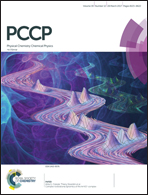Graphitic carbon coupled poly(anthraquinone) for proton shuttle flow-in-a-cell application†
Abstract
Coupled electron and proton transport are an integral part of non-gassing electro-osmotic pumps (EOP). The kinetics of the electrode limits the kinetics of the electron transfer and hence the flow. This is observed in the present study with newly synthesized graphitic carbon covalently coupled to poly(anthraquinone) (PAQ). When EOP with identical electrodes were assembled, proton shuttle maintained the reversible flow, which was linearly dependent on the ks values. A Laviron plot was used to calculate the electron-transfer rate constant ks and transfer coefficient α, and their linear dependency on content of graphitic carbon was observed. The best ks value obtained was 0.67 s−1 for 15PAQ. The sandwich-type flow-in-a-cell showed the best result of ∼40 μL min−1 cm−1 V−1 electro-osmotic flux for 15PAQ. It reveals that a balanced combination of graphitic carbon and PAQ is the prime requirement for high-performance electrode materials to be used in microfluidic devices and energy applications.



 Please wait while we load your content...
Please wait while we load your content...